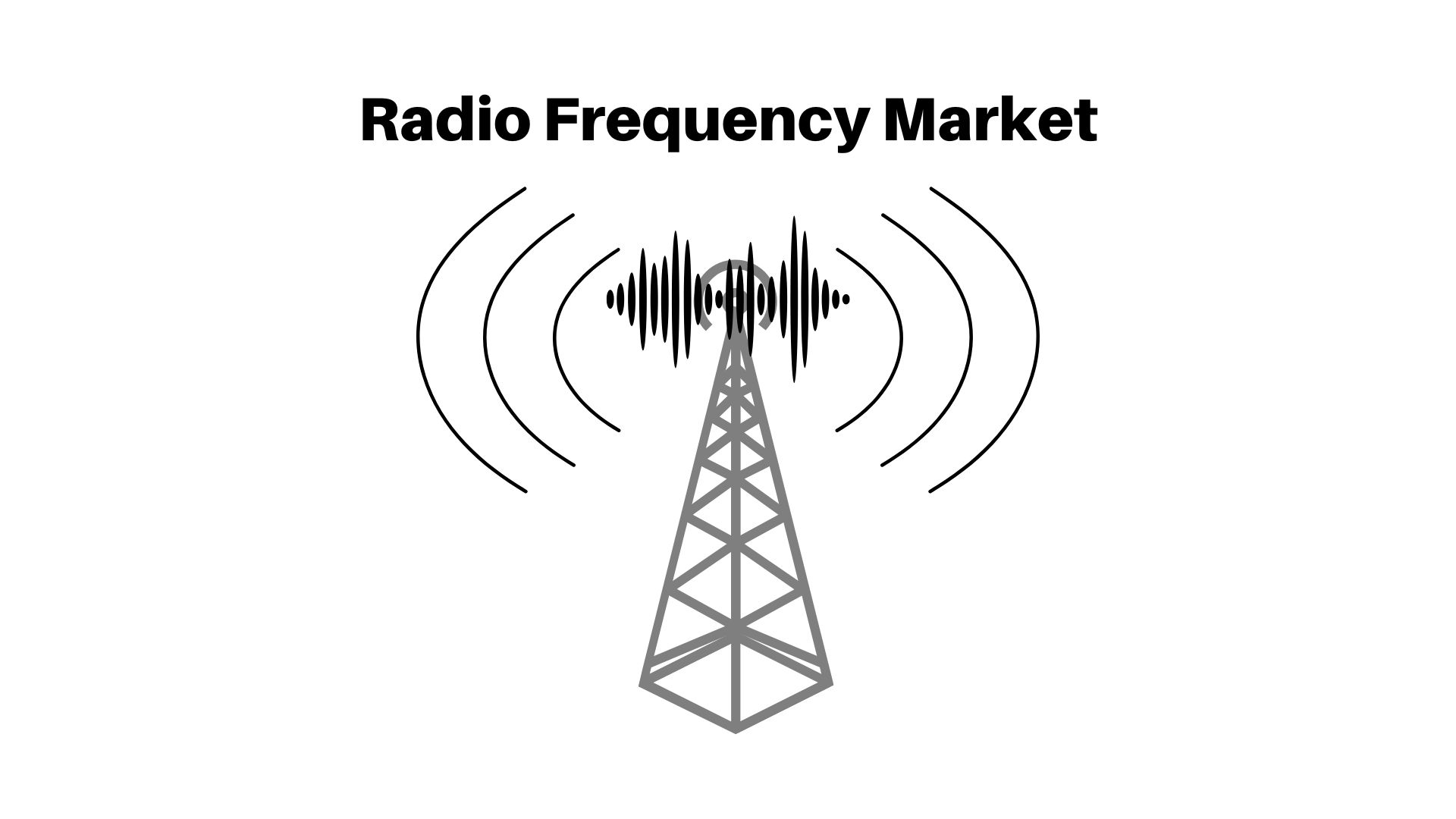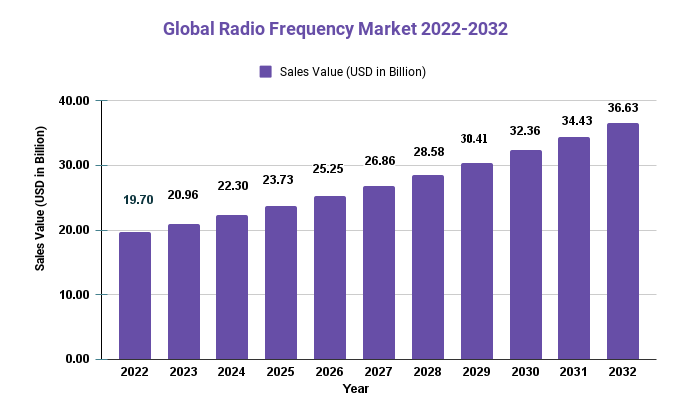6.4% CAGR of Radio Frequency Market Gain USD 36.63 billion by 2032 | Market.us

Page Contents
Published Via 11Press: The radio frequency (RF) market encompasses a vast array of products and applications, such as RF components, testing equipment, power amplifiers, filters and more. Estimating the size of this sector can be challenging due to its diverse mix of items.
Market.us reports that global radio frequency (RF) market will grow from USD 19.70 billion in 2022 to USD 36.63 billion by 2032 at an average compound annual growth rate (CAGR) of 6.4% during the forecast period.
Request For Sample Report Here | https://market.us/report/radio-frequency-market/request-sample

Regional Snapshot
- North America: North America ranks as one of the most important markets for RFtechnologies, and the United States has played a significant role in its expansion. North America's main drivers of the RF industry are its growing use of wireless communication devices, and IoT adoption.
- Europe: Europe has been a major market for RF-technology products. France, Germany and Britain are the leaders in Europe's growth. Europe's growth in the RF market will be driven by 5G technology's increasing acceptance and growing demand for mobile communication devices.
- Asia-Pacific: The Asia-Pacific region will continue to be the most important market for RF technology, thanks in part to India, Japan and China. The major factors driving the market for RF technologies in this region are growing mobile adoption and rising demand for internet connectivity.
- Rest of the World: The Rest of the World area includes Latin America. Middle East. and Africa. These areas have the fastest growing RF markets due to increased usage of wireless communication technology, rising demand for 5G technology, as well as increasing infrastructure investment.
Drivers
- Growing Demand for Wireless Communication: As more mobile devices such as smartphones, tablets and laptops become popular, there has been an uptick in demand for wireless communication technologies. Bluetooth, Wi-Fi and 5G are key in providing high-speed wireless connection – thus fueling growth within the RF market.
- Advancements in IoT Technology: The internet of things (IoT) is propelling growth in the RF market, as it requires reliable wireless communication infrastructure. Popular RF technologies such as Zigbee, LoRa, and NB-IoT are used for wireless communication in IoT devices; their increasing adoption is spurring demand for services within this space.
- Increased Demand for High-Speed Internet Connection: As consumers demand faster internet speeds, RF technologies such as 5G and Wi-Fi 6 are becoming more essential. 5G adoption is expected to fuel the growth of the RF market, since it requires a substantial amount of infrastructure in order to provide reliable wireless communication.
- Growing Demand for Consumer Electronics: The growing adoption of consumer electronics such as smartphones, smart TVs and wearable devices is fueling the growth of the RF market. Technologies like Bluetooth and Wi-Fi play a pivotal role in providing wireless connectivity to these gadgets.
Restraints
- High Deployment Costs: Adopting RF technology necessitates a significant investment in infrastructure and equipment, which may prove an obstacle for some organizations.
- Regulatory Challenges: The radio frequency (RF) market is subject to numerous regulations and standards, particularly within the telecommunications industry. Compliance with these rules can present a challenge for some organizations, especially those operating across multiple regions with distinct regulations.
- Security Concerns: RF technology can present security challenges, particularly in sensitive applications such as military and government communications. The potential for interception and interference are significant concerns, especially with the increasing complexity and sophistication of cyber attacks.
- Limited Spectrum Availability: Access to spectrum for RF applications can be limited, especially in densely populated areas where congestion can be an issue. This has the potential to restrict growth within the RF market, especially for applications requiring high bandwidth and low latency connections.
Opportunities
- Emergence of New Applications: With the demand for wireless connectivity continuing to increase, new applications utilizing RF technology such as the Internet of Things (IoT) and 5G networks are emerging. These initiatives are expected to fuel significant growth in the RF market over the coming years.
- Increased Adoption of RF Technology in Industrial and Commercial Applications: RF technology is increasingly finding use in industrial and commercial settings such as manufacturing, logistics, and retail. These tasks necessitate reliable and secure wireless connections – something RF technology perfectly meets.
- Development of New RF Technologies: Research and development are ongoing in the RF market, with new technologies being created that improve performance, lower power consumption, and extend range. These advances are expected to broaden RF technology's potential applications.
- Growth of the Automotive Industry: The automotive industry is increasingly adopting RF technology for applications such as infotainment, telematics and vehicle-to-vehicle (V2V) communication. The expansion of this sector is forecast to propel significant growth in the RF market over the coming years.
Challenges
- Spectrum Availability: Spectrum availability for RF applications is limited, and congestion can be a significant issue in densely populated areas. This may restrict the potential growth of the RF market, particularly for applications requiring high bandwidth and low latency connections.
- Regulatory Challenges: The radio frequency (RF) market is subject to numerous regulations and standards, particularly within the telecommunications industry. Complying with these rules can prove challenging for some organizations, particularly those operating across multiple regions with differing laws.
- Security Concerns: RF technology presents security risks, particularly in sensitive applications like military and government communications. The potential for interception and interference pose a significant concern, particularly as cyber attacks continue to evolve in complexity and sophistication.
- Technological Limitations: While RF technology has made significant strides in recent years, there remain technical constraints that can impact its performance, particularly regarding range, interference and power consumption. These restrictions may limit RF's potential applications beyond specialized tasks, however.
Do Inquiry Before Buying This Report Here | https://market.us/report/radio-frequency-market/#inquiry
Recent Developments
- Advances in 5G Technology: 5G networks employ RF technology to provide high-speed wireless connectivity, and there have been significant advancements in this area recently. These improvements include increased network speed and capacity as well as the development of new use cases for 5G such as industrial IoT or smart cities.
- Increased Utilization of RF in Automotive Applications: The automotive industry is increasingly utilizing RF technology for various purposes, such as vehicle-to-vehicle (V2V) and vehicle-to-infrastructure (V2I) communications, in-car entertainment systems and safety features.
Key Market Segments:
Type
- Power Amplifiers
- Transceivers
- Wi-Fi
- Bluetooth
- NFC
- WiMAX
- GPS
- FM
- Wireless USB
- Mobile TV
Application
- Commercial
- Civil
- Military
Key Market Players
- Skyworks
- Qorvo
- Avago
- Murata
- Sumitomo Electric
- Mitsubishi Electric
- Analog Devices
- Infineon
- RDA
- Microchip
- Texas Instruments
- Samsung
- Microsemi
- Cypress
- Anadigics
- China Unichip
- Xilinx
- IDT
- Vanchip
- Junheng
Report Scope
| Report Attribute | Details |
| The market size value in 2022 | USD 19.70 Bn |
| Revenue forecast by 2032 | USD 36.63 Bn |
| Growth Rate | CAGR Of 6.4% |
| Regions Covered | North America, Europe, Asia Pacific, Latin America, and Middle East & Africa, and Rest of the World |
| Historical Years | 2017-2022 |
| Base Year | 2022 |
| Estimated Year | 2023 |
| Short-Term Projection Year | 2028 |
| Long-Term Projected Year | 2032 |
Frequently Asked Question
Q: What is the current market size for the Radio Frequency Market?
A: According to a report by Market.us, the Radio Frequency Market was valued at USD 19.70 billion in 2022 and is expected to reach USD 36.63 billion by 2032, growing at a CAGR of 6.4% during the forecast period.
Q: What are the key segments of the Radio Frequency Market?
A: The Radio Frequency Market can be segmented based on By Type (Power Amplifiers, Transceivers, Wi-Fi, Bluetooth, NFC, WiMAX, GPS, FM, Wireless USB, Mobile TV), By Application (Commercial, Civil, Military), and geography (North America, Europe, Asia-Pacific, Latin America, and Middle East & Africa).
Q: Who are the key players in the Radio Frequency Market?
A: Some of the key players in the Radio Frequency Market include Skyworks, Qorvo, Avago, Murata, Sumitomo Electric, Mitsubishi Electric, Analog Devices, Infineon, RDA, Microchip, Texas Instruments, Samsung, Microsemi, Cypress, Anadigics, China Unichip, Xilinx, IDT, Vanchip, Junheng.
The team behind market.us, marketresearch.biz, market.biz and more. Our purpose is to keep our customers ahead of the game with regard to the markets. They may fluctuate up or down, but we will help you to stay ahead of the curve in these market fluctuations. Our consistent growth and ability to deliver in-depth analyses and market insight has engaged genuine market players. They have faith in us to offer the data and information they require to make balanced and decisive marketing decisions.



